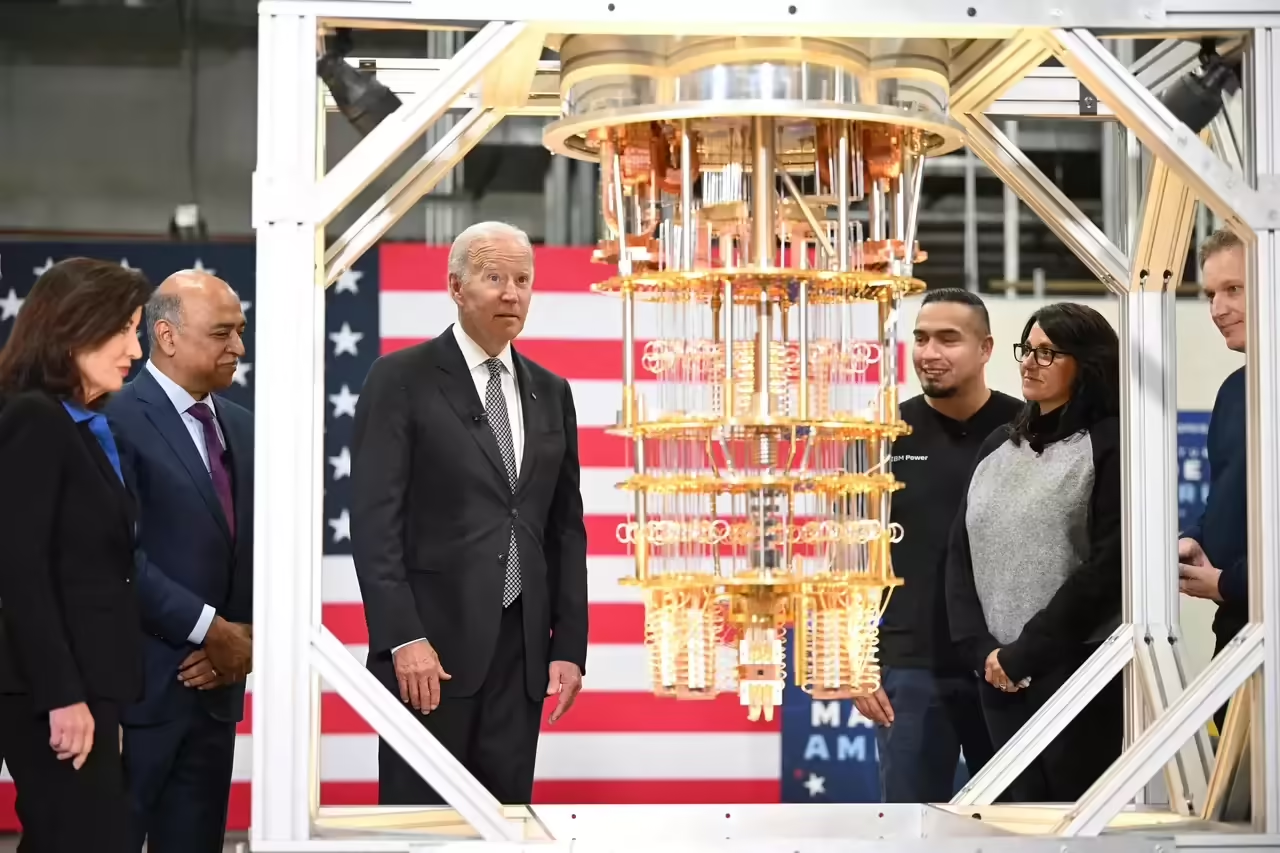
In the ever-evolving landscape of computing, there is a groundbreaking technological shift on the horizon – the era of quantum computing. Leading the charge in this exciting realm is IBM, a company renowned for its innovation and commitment to advancing the frontiers of technology. In this article, we’ll delve into the fascinating world of IBM’s quantum supercomputer, a marvel of science and engineering set to redefine the boundaries of computational power.
The Quantum Computing Revolution
Conventional computers, like the one you might be reading this article on, operate based on bits, the smallest units of information represented as either 0 or 1. Quantum computers, on the other hand, leverage the principles of quantum mechanics and qubits, which can exist in multiple states simultaneously. This fundamental difference in computing architecture unlocks the potential for quantum computers to perform certain types of calculations exponentially faster than classical computers.
IBM’s Quantum Endeavor
IBM’s venture into quantum computing began in earnest with the creation of the IBM Quantum Experience, a platform that allowed users to experiment with early quantum processors via the cloud. This pioneering move democratized access to quantum computing and encouraged the global scientific community to explore the technology’s capabilities.
Over the years, IBM has consistently pushed the boundaries of quantum computing, releasing increasingly powerful and stable quantum processors. They’ve developed a family of quantum systems, including the IBM Q System One, and have made tremendous strides in error correction and qubit stability.
The IBM Quantum Ecosystem
IBM’s commitment to quantum computing goes beyond hardware. They’ve established the IBM Quantum Network, a consortium of like-minded organizations and researchers collaborating to unlock the true potential of quantum computing. This network facilitates research and development in various domains, from cryptography to drug discovery.
Additionally, IBM offers a comprehensive suite of tools and resources, such as Qiskit, an open-source quantum computing framework. These resources enable developers and researchers to build and experiment with quantum algorithms, contributing to the collective growth of quantum knowledge.
A Quantum Future in the Making
IBM’s quantum supercomputer, with its ever-increasing qubit count and computational power, promises to revolutionize fields as diverse as materials science, optimization, and artificial intelligence. It holds the potential to solve complex problems that were previously deemed insurmountable.
As we move forward into the quantum era, IBM’s commitment to pushing the boundaries of technology remains unwavering. Their efforts in democratizing quantum access and fostering collaboration are laying the foundation for a future where quantum computing will transform our world.
In the coming years, IBM’s vision will become a reality as they plan to install a quantum supercomputer in San Sebastián, Spain, further cementing their dedication to advancing the frontiers of quantum computing. Stay tuned for more on this exciting development, and prepare to witness the power of quantum computing redefining what’s possible in the realm of technology.
San Sebastián as the New Home for Quantum Technology
In the picturesque city of San Sebastián, nestled along the northern coast of Spain, a technological revolution is on the horizon that promises to reshape the landscape of computing and scientific discovery. This transformation comes in the form of IBM’s quantum supercomputer, a groundbreaking endeavor set to find its new home in this charming Spanish city by the year 2025. As we explore the convergence of tradition and cutting-edge technology, San Sebastián is poised to become a hub for quantum innovation.
A Quantum Leap for San Sebastián
San Sebastián, with its rich history, stunning landscapes, and renowned culinary culture, may seem an unlikely place for a quantum computing powerhouse. However, the decision to host IBM’s quantum supercomputer is indicative of the city’s growing significance in the world of technology and innovation. This move not only places San Sebastián on the global tech map but also promises numerous benefits for the region and its residents.
A Hub for Scientific Advancement
IBM’s choice to establish a quantum computing center in San Sebastián signifies the city’s commitment to fostering scientific advancement. Quantum computing, with its potential to solve complex problems at an unprecedented speed, holds the key to unlocking breakthroughs in fields such as healthcare, materials science, and climate modeling. San Sebastián’s embrace of this technology positions it as a driving force behind these future advancements.
Collaborative Partnerships
The collaboration between IBM and San Sebastián extends beyond the installation of a quantum supercomputer. This partnership involves a dynamic interchange of knowledge and resources, drawing on the expertise of local researchers and the global reach of IBM’s quantum network. San Sebastián’s academic and research institutions are set to play a pivotal role in this endeavor, enriching the global quantum community.
Educational and Economic Opportunities
The presence of a quantum computing center in San Sebastián is expected to fuel educational opportunities for local students and professionals. It will offer access to cutting-edge research and technology, creating a nurturing environment for future innovators. Simultaneously, the city’s economy stands to benefit from the influx of talent and investment, solidifying its status as a destination for tech-driven growth.
A Bridge Between Tradition and Innovation
As San Sebastián embraces quantum technology, it continues to honor its rich cultural heritage. The city’s vibrant traditions and historical significance harmoniously coexist with its burgeoning tech scene. This unique blend of the old and the new is emblematic of the global shift towards marrying tradition with innovation, and San Sebastián stands as an exemplar of this transformative paradigm.
IBM and Its Commitment to Quantum Computing
In the ever-accelerating race toward the future of computing, IBM has emerged as a prominent player with an unwavering commitment to revolutionizing the technological landscape through quantum computing.
Pioneering Quantum Exploration
IBM’s journey into the realm of quantum computing dates back to its early experiments with quantum information processing. Their innovative strides began with the creation of the IBM Quantum Experience, a cloud-based platform that allowed users worldwide to experiment with quantum processors and quantum algorithms. This move marked a significant step towards democratizing quantum computing, as it offered access to quantum experimentation for researchers, scientists, and enthusiasts alike.
Quantum Hardware Advancements
IBM’s dedication to the quantum domain extends well beyond conceptualization. The company has consistently pushed the envelope by introducing increasingly powerful quantum processors, each with more qubits and enhanced stability. These milestones have not only paved the way for complex quantum simulations but have also encouraged researchers to dream big and tackle problems previously deemed intractable.
IBM’s groundbreaking achievement was the introduction of the IBM Q System One, the world’s first integrated quantum computer, with an elegant design and a significant leap in quantum hardware engineering. This marked an important milestone in bringing quantum computing closer to reality.
Fostering Quantum Knowledge
IBM’s commitment to quantum computing is not limited to hardware alone. The company understands that the growth of quantum technology depends on a flourishing ecosystem of knowledge and expertise. IBM has introduced Qiskit, an open-source quantum computing framework, allowing developers and researchers to experiment and build quantum algorithms, contributing to the collective understanding of this pioneering technology.
The IBM Quantum Network
Collaboration is at the core of IBM’s quantum endeavors. They’ve established the IBM Quantum Network, a global community of organizations and researchers who collaborate to explore the potential of quantum computing across various domains. This network facilitates interdisciplinary research, bringing together minds from academia, industry, and beyond to unlock the full spectrum of quantum possibilities.
The Path Forward
IBM’s relentless pursuit of quantum computing is not just a scientific endeavor but a visionary quest to tackle some of the world’s most challenging problems. As we move closer to the quantum era, the company is poised to install a quantum supercomputer in San Sebastián, Spain, in 2025. This development further solidifies IBM’s unwavering dedication to pushing the boundaries of technology and unlocking the immense potential of quantum computing.
Expectations and Challenges for 2025
As the year 2025 approaches, the world of quantum computing stands on the cusp of a transformative era. With IBM’s superconducting quantum computer set to find its new home in San Sebastián, Spain, and the broader evolution of quantum technology, a set of significant expectations and challenges emerge on the horizon.
Expectations for Quantum Computing
Accelerated Scientific Discovery: Quantum computing promises to revolutionize the way we approach complex problems in fields such as chemistry, material science, and drug discovery. The expectation is that quantum computers will dramatically expedite the process of simulating and discovering new materials and drugs.
Optimization Breakthroughs: Quantum algorithms are expected to bring a paradigm shift in optimization problems, potentially revolutionizing logistics, supply chain management, and financial modeling.
Quantum-Safe Cryptography: With the rise of quantum computing comes the threat of breaking current encryption methods. The expectation is that quantum-safe cryptographic solutions will be developed to counter this threat.
Quantum Artificial Intelligence: Quantum computing is anticipated to enhance machine learning algorithms, leading to more powerful AI models that can process data at unprecedented speeds.
Interdisciplinary Collaborations: Quantum technology’s interdisciplinary nature is expected to foster collaborations between scientists, engineers, and industries, driving innovation in various domains.
Challenges Ahead
Hardware Limitations: Achieving and maintaining the stability and coherence of quantum bits (qubits) remains a formidable challenge. Quantum error correction and increasing qubit counts are essential but face technical hurdles.
Scalability: Scaling quantum computers to a level where they can solve real-world problems efficiently is a complex challenge. Quantum computers need to outperform classical computers across a broad range of tasks.
Algorithm Development: Developing practical quantum algorithms for a wide range of applications is a challenge. Many quantum algorithms remain in the theoretical stage and need to be translated into practical implementations.
Cost and Accessibility: Quantum computing infrastructure can be expensive and inaccessible to many researchers and organizations. Ensuring affordability and accessibility will be a critical challenge.
Ethical and Security Concerns: Quantum computing can disrupt security protocols, and its potential applications may raise ethical concerns. Addressing these issues will be essential for responsible development.
Regulatory Frameworks: As quantum technology advances, governments and international bodies will need to develop regulatory frameworks to ensure responsible use and mitigate potential risks.







